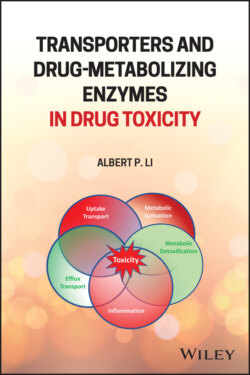Читать книгу Transporters and Drug-Metabolizing Enzymes in Drug Toxicity - Albert P. Li - Страница 24
2.2.2 Phase II Metabolism
ОглавлениеPhase II metabolism is composed of a series of reactions, including glucuronidation, sulfoconjugation, glutathione (GSH) S‐conjugation, acetylation, and methylation. They introduce glucuronic acid, sulfate, amino acids, or GSH molecules to phase I products and form conjugates, which increase water solubility and decrease pharmacologic activity; and finally, enhance detoxification of the compounds.
Glucuronidation accounts for the conjugation of about 40–70% of marketed drugs in humans, and UDP‐glucuronosyltransferases (UGTs) are the key enzymes metabolizing various exogenous and endogenous compounds.
Sulfoconjugation (or sulfonation), generally described as a detoxification pathway for many xenobiotics, is mediated by a supergene family of enzymes called sulfotransferases (SULTs). The phase I active molecules can form a water‐soluble compound by adding the sulfonate moiety, which can easily be removed from the body.
GSH S‐conjugation plays a critical defensive role against oxidative stress. The family of glutathione S‐transferases (GSTs) helps detoxify reactive intermediates formed by other metabolizing enzymes derived from drugs, chemicals, and environmental carcinogens.
Acetylation reactions are mostly driven by two N‐acetyltransferase isoenzymes (NATs), NAT1, and NAT2, in humans. Most drugs in acetylation reactions either are hydrazines or aromatic amines.
Methylation is a minor pathway of xenobiotic biotransformation, which does not dramatically change the solubility of substrates. It is primarily involved in the metabolism of small endogenous compounds and certain drugs.
